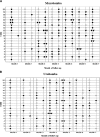Diarrheagenic Escherichia coli: Prevalence and Pathotype Distribution in Children from Peruvian Rural Communities
- PMID: 27382080
- PMCID: PMC5014262
- DOI: 10.4269/ajtmh.16-0220
Diarrheagenic Escherichia coli: Prevalence and Pathotype Distribution in Children from Peruvian Rural Communities
Abstract
Diarrheagenic Escherichia coli (DEC) are common pathogens of childhood gastrointestinal infections worldwide. To date, research tracking DEC has mainly been completed in urban areas. This study aims to determine the prevalence and pathotype distribution of DEC strains in children from rural Peruvian communities and to establish their association with malnutrition. In this prospective cohort, 93 children aged 6-13 months from rural communities of Urubamba (Andes) and Moyobamba (jungle) were followed for 6 months. Diarrheal and control stool samples were analyzed using multiplex real-time polymerase chain reaction to identify the presence of virulence genes of DEC strains. The overall isolation rate of DEC was 43.0% (352/820). Enteroaggregative E. coli (EAEC, 20.4%), enteropathogenic E. coli (EPEC, 14.2%), and diffusely aggregative E. coli (DAEC, 11.0%) were the most prevalent pathotypes. EAEC was more frequently found in Moyobamba samples (P < 0.01). EPEC was the only strain significantly more frequent in diarrheal than asymptomatic control samples (P < 0.01). DEC strains were more prevalent among younger children (aged 6-12 months, P < 0.05). A decline in height-for-age Z-score (HAZ) was observed in 75.7% of children overall. EAEC was more frequently isolated among children who had a greater HAZ decline (P < 0.05). In conclusion, DEC strains were frequently found in stool samples from children in rural communities of the highlands and jungle of Peru. In addition, children with a greater decline in their growth rate had higher EAEC isolation rates, highlighting the importance of this pathogen in child malnutrition.
© The American Society of Tropical Medicine and Hygiene.
Figures



Similar articles
-
High prevalence of diarrheagenic Escherichia coli carrying toxin-encoding genes isolated from children and adults in southeastern Brazil.BMC Infect Dis. 2017 Dec 18;17(1):773. doi: 10.1186/s12879-017-2872-0. BMC Infect Dis. 2017. PMID: 29254489 Free PMC article.
-
[Frequency and pathotypes of diarrheagenic Escherichia coli in Peruvian children with and without diarrhea].Rev Peru Med Exp Salud Publica. 2011 Mar;28(1):13-20. doi: 10.1590/s1726-46342011000100003. Rev Peru Med Exp Salud Publica. 2011. PMID: 21537764 Spanish.
-
Genotypic and phenotypic analysis of diarrheagenic Escherichia coli strains isolated from Brazilian children living in low socioeconomic level communities.BMC Infect Dis. 2013 Sep 8;13:418. doi: 10.1186/1471-2334-13-418. BMC Infect Dis. 2013. PMID: 24010735 Free PMC article.
-
[Virulence mechanisms of enteropathogenic Escherichia coli].Rev Chilena Infectol. 2016 Aug;33(4):438-450. doi: 10.4067/S0716-10182016000400009. Rev Chilena Infectol. 2016. PMID: 27905628 Review. Spanish.
-
Diarrheagenic Escherichia coli in sub-Saharan Africa: status, uncertainties and necessities.J Infect Dev Ctries. 2009 Nov 27;3(11):817-42. doi: 10.3855/jidc.586. J Infect Dev Ctries. 2009. PMID: 20061678 Review.
Cited by
-
A One Health Perspective for Defining and Deciphering Escherichia coli Pathogenic Potential in Multiple Hosts.Comp Med. 2021 Feb 1;71(1):3-45. doi: 10.30802/AALAS-CM-20-000054. Epub 2021 Jan 8. Comp Med. 2021. PMID: 33419487 Free PMC article. Review.
-
Antibiofilm agents with therapeutic potential against enteroaggregative Escherichia coli.PLoS Negl Trop Dis. 2022 Oct 6;16(10):e0010809. doi: 10.1371/journal.pntd.0010809. eCollection 2022 Oct. PLoS Negl Trop Dis. 2022. PMID: 36201560 Free PMC article.
-
Molecular characterization of diarrheagenic Escherichia coli pathotypes: Association of virulent genes, serogroups, and antibiotic resistance among moderate-to-severe diarrhea patients.J Clin Lab Anal. 2018 Jun;32(5):e22388. doi: 10.1002/jcla.22388. Epub 2018 Jan 21. J Clin Lab Anal. 2018. PMID: 29356079 Free PMC article.
-
Stunting Is Preceded by Intestinal Mucosal Damage and Microbiome Changes and Is Associated with Systemic Inflammation in a Cohort of Peruvian Infants.Am J Trop Med Hyg. 2019 Nov;101(5):1009-1017. doi: 10.4269/ajtmh.18-0975. Am J Trop Med Hyg. 2019. PMID: 31482782 Free PMC article.
-
Gut biomolecules (I-FABP, TFF3 and lipocalin-2) are associated with linear growth and biomarkers of environmental enteric dysfunction (EED) in Bangladeshi children.Sci Rep. 2022 Aug 16;12(1):13905. doi: 10.1038/s41598-022-18141-8. Sci Rep. 2022. PMID: 35974137 Free PMC article.
References
-
- O'Ryan M, Prado V, Pickering LK. A millennium update on pediatric diarrheal illness in the developing world. Semin Pediatr Infect Dis. 2005;16:125–136. - PubMed
-
- Kotloff KL, Nataro JP, Blackwelder WC, Nasrin D, Farag TH, Panchalingam S, Wu Y, Sow SO, Sur D, Breiman RF, Faruque AS, Zaidi AK, Saha D, Alonso PL, Tamboura B, Sanogo D, Onwuchekwa U, Manna B, Ramamurthy T, Kanungo S, Ochieng JB, Omore R, Oundo JO, Hossain A, Das SK, Ahmed S, Qureshi S, Quadri F, Adegbola RA, Antonio M, Hossain MJ, Akinsola A, Mandomando I, Nhampossa T, Acácio S, Biswas K, O'Reilly CE, Mintz ED, Berkeley LY, Muhsen K, Sommerfelt H, Robins-Browne RM, Levine MM. Burden and aetiology of diarrhoeal disease in infants and young children in developing countries (the Global Enteric Multicentre Study, GEMS): a prospective, case-control study. Lancet. 2013;382:209–222. - PubMed
-
- Lanata CF, Mendoza W. Improving Diarrhoea Estimates. 2002. http://www.who.int/child_adolescent_health/documents/pdfs/improving_diar... Available at. Accessed February 24, 2016.
Publication types
MeSH terms
LinkOut - more resources
Full Text Sources
Other Literature Sources
Medical
Research Materials

